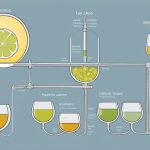When it comes to enjoying a great beer, flavor is king. The flavor of beer is influenced by a variety of factors that come together to create a unique and delicious experience. As a beer enthusiast, I have spent countless hours exploring the nuances and complexities of different beers, and I’m excited to share my knowledge with you. So, grab a pint and let’s dive deep into the three factors that affect the flavor of beer.
1. Ingredients
Beer is made from a combination of four primary ingredients: water, malted barley, hops, and yeast. Each ingredient plays a crucial role in shaping the flavor profile of the beer.
Water: Believe it or not, water is the main component of beer, typically making up about 90% of the total volume. The mineral content and pH level of the water can have a significant impact on the flavor of the beer. For example, soft water with low mineral content is ideal for brewing light, delicate beers, while hard water with higher mineral content is better suited for brewing hop-forward beers like IPAs.
Malted Barley: Barley is the primary grain used in brewing beer. The malting process involves soaking the barley in water, allowing it to germinate, and then drying it out. This process activates enzymes in the barley that convert starches into fermentable sugars. The type and roast level of the malted barley can contribute flavors ranging from sweet caramel to rich chocolate, adding depth and complexity to the beer.
Hops: Hops are the flowers of the hop plant and provide bitterness, aroma, and flavor to the beer. The type of hops used and the timing of their addition during the brewing process can greatly influence the taste of the beer. Hops can contribute flavors such as citrus, pine, floral, and even herbal notes, balancing out the sweetness of the malt and adding a refreshing bitterness.
Yeast: Yeast is responsible for fermentation, where it consumes the sugars in the beer and produces alcohol and carbon dioxide. The type of yeast used, whether it’s ale yeast or lager yeast, can significantly impact the flavor profile of the beer. Ale yeast tends to produce fruity and estery flavors, while lager yeast creates a cleaner and crisper taste.
2. Brewing Process
The brewing process itself also plays a vital role in the flavor development of beer. Various factors, such as temperature, time, and fermentation conditions, can greatly influence the final taste.
Mashing and Boiling: During the mashing process, the malted barley is mixed with hot water to extract fermentable sugars. The temperature and duration of this process can affect the sweetness and body of the beer. Boiling the wort (the liquid extracted from the mash) helps to sanitize the beer and extract hop bitterness.
Fermentation: The fermentation process is where the magic happens. The yeast consumes the sugars in the beer, producing alcohol and carbon dioxide. The temperature and type of yeast used during fermentation can impact the flavor and aroma of the beer. Some breweries even use specialized yeast strains to create unique and distinct flavors.
Aging and Conditioning: After fermentation, many beers go through a period of aging and conditioning. This can happen in tanks, barrels, or bottles. During this time, flavors can further develop and mellow, resulting in a smoother and more complex beer.
3. External Factors
Lastly, external factors can also influence the flavor of beer. These factors include storage conditions, serving temperature, glassware, and even the company you keep while enjoying a pint.
Storage: Proper storage is essential to preserve the quality and flavor of beer. Exposure to light and extremes of temperature can result in off-flavors and spoilage. Beers should be stored in a cool, dark place to maintain their freshness.
Serving Temperature: The temperature at which beer is served can greatly affect its flavor. Different beer styles have different recommended serving temperatures. For example, lighter beers are generally served colder, while darker and stronger beers are served slightly warmer to allow the flavors to shine.
Glassware: Believe it or not, the shape and type of glassware can impact the flavor experience. The right glass can enhance aromas, promote proper carbonation, and provide an overall better tasting experience.
Enjoyment: Lastly, the company you keep and the atmosphere in which you drink beer can influence your perception of its flavor. Sharing a favorite beer with friends or enjoying a pint at your favorite pub can enhance the overall enjoyment of the beer.
So, the next time you raise a glass, take a moment to appreciate the intricate factors that have come together to create the delightful flavors in your beer. From the carefully selected ingredients to the artful brewing process, and the external conditions, each element contributes to the complex symphony of flavors that make beer a truly remarkable beverage.
Cheers!







